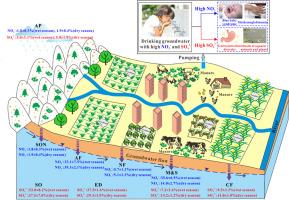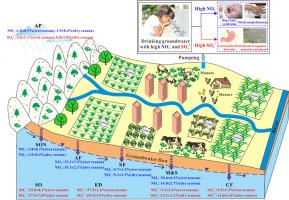Spatiotemporal characteristics, drivers, sources, and health risks of nitrate and sulfate in groundwater on the Chinese Loess Plateau
IF 12.4
1区 环境科学与生态学
Q1 ENGINEERING, ENVIRONMENTAL
引用次数: 0
Abstract
Groundwater nitrate (NO3-) and sulfate (SO42-) pollution in semi-arid regions has attracted widespread attention. However, unveiling the dynamics and sources of NO3- and SO42- in regional groundwater is challenging because of complex anthropogenic activities and hydrogeological conditions. This study combined physicochemistry and multiple stable isotopes (δ2H-H2O, δ18O-H2O, δ15N-NO3-, δ18O-NO3-, δ34S-SO42-, and δ18O-SO42-) to explore the spatiotemporal patterns, driving factors, sources, and potential health hazards of NO3- and SO42- in groundwater on the Loess Plateau, China. Results showed that NO3- and SO42- concentrations exhibited significant spatiotemporal variations between the wet and dry seasons. The primary factors controlling the NO3- spatial difference were NDVI, land use type, and distance to mining area and precipitation, distance to mining area, and NDVI in the wet and dry seasons, respectively. Distance to river, precipitation, and evaporation in the wet season and NDVI, precipitation, and elevation in the dry season were the dominant drivers of spatial heterogeneity in SO42-. The explanatory power of the interaction between the two factors was greater than that of any individual factor. Soil organic nitrogen, ammonium fertilizer, and manure and sewage attributed to agricultural activities contributed the most to NO3- in groundwater. Sulfide oxidation and evaporite dissolution were the most prominent SO42- sources. Denitrification and sulfate reduction were prevalent in the wet season, while nitrification was dominant in the dry season. Health risk assessment suggested that children faced higher non-carcinogenic risks than adults in both wet and dry seasons. This study provides valuable insights into regional scale groundwater pollution in semi-arid regions.


黄土高原地下水中硝酸盐和硫酸盐的时空特征、驱动因素、来源及健康风险
半干旱区地下水硝酸盐(NO3-)和硫酸盐(SO42-)污染引起了广泛关注。然而,由于复杂的人为活动和水文地质条件,揭示区域地下水中NO3-和SO42-的动态和来源具有挑战性。本研究采用物理化学和多种稳定同位素(δ2H-H2O、δ18O-H2O、δ15N-NO3-、δ18O-NO3-、δ34S-SO42-和δ18O-SO42-)相结合的方法,探讨了黄土高原地下水中NO3-和SO42-的时空格局、驱动因素、来源和潜在健康危害。结果表明,干湿季节NO3-和SO42-浓度存在显著的时空差异。控制NO3-空间差异的主要因子分别是NDVI、土地利用类型、与矿区的距离和降水、与矿区的距离、旱季的NDVI。湿季与河流的距离、降水和蒸发量、旱季NDVI、降水和海拔高度是影响SO42-空间异质性的主要因素。两个因素之间相互作用的解释力大于任何单个因素的解释力。土壤有机氮、铵肥和农业活动粪污对地下水NO3-的贡献最大。硫化物氧化和蒸发岩溶解是SO42的主要来源。湿季以反硝化和硫酸盐还原为主,旱季以硝化为主。健康风险评估表明,在旱季和雨季,儿童面临的非致癌风险都高于成人。该研究为研究半干旱区区域尺度的地下水污染提供了有价值的见解。
本文章由计算机程序翻译,如有差异,请以英文原文为准。
求助全文
约1分钟内获得全文
求助全文
来源期刊

Water Research
环境科学-工程:环境
CiteScore
20.80
自引率
9.40%
发文量
1307
审稿时长
38 days
期刊介绍:
Water Research, along with its open access companion journal Water Research X, serves as a platform for publishing original research papers covering various aspects of the science and technology related to the anthropogenic water cycle, water quality, and its management worldwide. The audience targeted by the journal comprises biologists, chemical engineers, chemists, civil engineers, environmental engineers, limnologists, and microbiologists. The scope of the journal include:
•Treatment processes for water and wastewaters (municipal, agricultural, industrial, and on-site treatment), including resource recovery and residuals management;
•Urban hydrology including sewer systems, stormwater management, and green infrastructure;
•Drinking water treatment and distribution;
•Potable and non-potable water reuse;
•Sanitation, public health, and risk assessment;
•Anaerobic digestion, solid and hazardous waste management, including source characterization and the effects and control of leachates and gaseous emissions;
•Contaminants (chemical, microbial, anthropogenic particles such as nanoparticles or microplastics) and related water quality sensing, monitoring, fate, and assessment;
•Anthropogenic impacts on inland, tidal, coastal and urban waters, focusing on surface and ground waters, and point and non-point sources of pollution;
•Environmental restoration, linked to surface water, groundwater and groundwater remediation;
•Analysis of the interfaces between sediments and water, and between water and atmosphere, focusing specifically on anthropogenic impacts;
•Mathematical modelling, systems analysis, machine learning, and beneficial use of big data related to the anthropogenic water cycle;
•Socio-economic, policy, and regulations studies.
 求助内容:
求助内容: 应助结果提醒方式:
应助结果提醒方式:


